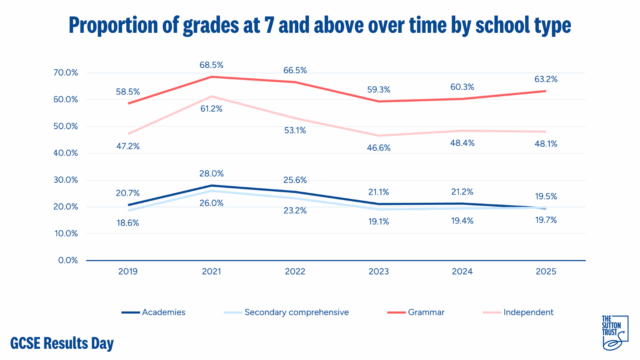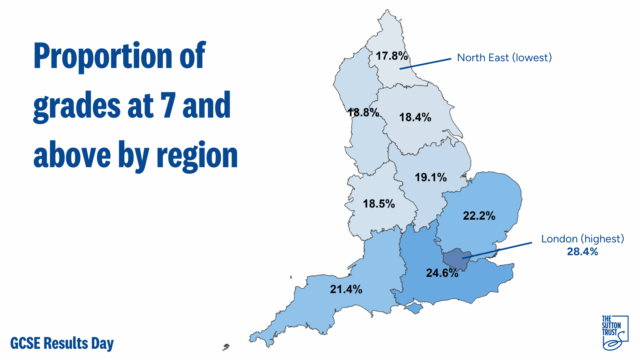Press Releases
Commenting on today’s GCSE results data, Nick Harrison, CEO of the Sutton Trust, said:
“Pupils receiving their results today should be proud of their achievements, especially considering the disrupted start to their secondary education due to the pandemic school closures.
“Today’s results show that regional differences in attainment remain stubbornly entrenched, with London continuing to streak ahead in terms of top grades. These regional gaps have widened significantly since 2019 and show no signs of improving.
“While it’s encouraging to see the gap between pupils in state and private schools getting top grades has narrowed slightly, this needs to be taken with a pinch of salt. This gap had already widened last year, and remains no better than in 2019.”
“If the Government is serious about breaking down barriers to opportunity, it needs a laser focus on closing the attainment gap and tackling regional inequalities. Funding should be rebalanced back towards the most deprived areas, and underlying issues of child poverty and huge gaps in opportunity across the country must be addressed.”
Sutton Trust analysis of today’s data:
Overall results
GCSE results in the UK overall are similar to 2024. 21.9% achieved grades at 7/A or above, compared to 21.8% in 2024. Passes at 4/C and above were 67.4%, compared to 67.6% last year.
In England the figures were 21.8% at 7 and above, compared to 21.7% last year and slightly above 20.7% in 2019. For passes at 4 and above, the rate is 67.1%, down from 67.4% in 2024 and the same as 2019 before the pandemic.
School type
The gap between private (48.1%) and state comprehensive school (19.7%) pupils getting the top grades has narrowed slightly from 29pp in 2024 to 28.4pp this year. This is similar to the gap in 2019. The proportion getting 7 or above decreased at academies this year (down from 21.2% to 19.5%), relative to other comprehensive schools, which increased from 19.4% to 19.7%.
A key post-pandemic trend has been grammar schools outperforming both non-selective state schools and independent schools. 63.2% of grammar school pupils achieved top grades, compared to 19.7% at comprehensives and 48.1% at independent schools. This was up 2.9 percentage points on last year, while the figure at comprehensives was up slightly, and at independent schools down slightly.
Compared to pre-pandemic levels, the proportion achieving top grades at grammars has increased by 4.7 percentage points, at comprehensives it is up 1.1 pp and independent schools 0.9pp. Grammar schools tend to cater to more affluent intakes to other state schools, with pupils facing fewer challenges in terms of the pandemic and cost of living crisis.
Regional differences
Unlike at A Levels, regional gaps are largely unchanged since last year. 28.4% of pupils in London achieved grade 7 or above (down 0.1pp from last year), compared to 17.8% in the North East (unchanged since last year).
However, gaps since 2019 have widened significantly and remain so. Top grades have increased more in London compared to pre-pandemic levels than anywhere else.
Gender
Gender gaps decreased this year. Across the UK, 19.4% of male and 24.5% of female pupils achieved top grades of 7/A or above. The gap of 5.1 pp is slightly lower than the 5.7pp in 2024. The gap in passing grades at 4 and above decreased similarly, from 6.8pp to 6.2pp.
National reference test
The National Reference Test analyses performance in English and maths each year in a consistent way, independent of changes in grade boundaries, allowing comparisons between year cohorts.
Performance in English showed signs of an increase this year, both in terms of top grades and passing grades. Passing grades remain below pre-pandemic levels.
In maths, there was little sign of change since 2024. Pass rates were similar to pre-pandemic levels, and top grades were slightly higher.
Media contacts:
E: [email protected]
D: 0204 536 4632 (includes out of hours)

